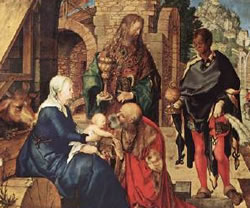 |
|
The Adoration of the Magi Albrecht Dürer (1504 CE; detail) |
The word ‘epiphany’ is derived from the Greek epiphaneia, meaning ‘manifestation’ or ‘to appear’. In a religious context, it describes the appearance of the holy in visible or audible form, and in Christianity it refers specifically to the various manifestations of God. The festival of Epiphany commemorates several such ‘showings’, including the Star of Bethlehem and the appearance of the angels to the shepherds—both of which heralded the manifestation of God in the form of the birth of Christ. It also marks the arrival of the three wise men—the Magi—who had seen the star in the sky and had followed it to Bethlehem.
Jesus’ baptism in the Jordan River is also remembered on this day, as it was on this occasion that another epiphany occurred, a voice issuing from heaven proclaiming Christ’s divinity.
In the early centuries, all of these events were celebrated on the same day. It was not until the fourth century CE that the Church of Rome transferred the commemoration of Christ’s birth from Epiphany to 25 December, the day of the pagan festival of Natalis Invicti, held to mark the joyous rebirth of the sun at the point of the winter solstice.
Eastern Orthodox traditions still celebrate Epiphany and Christmas together, but other Christians celebrate Epiphany as the end of the Christmas season—the “Twelfth Day” of Christmas—when decorations are removed and the tree is taken down. In some regions it is also called the “Feast of the Holy Kings” or “Three Kings’ Day”, and presents are given in memory of the gifts—gold, frankinsence and myrrh—that the Magi bestowed on Christ.